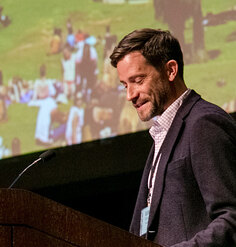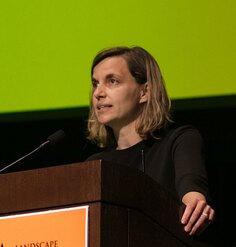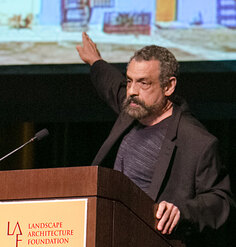Landscape City
By James Corner
This presentation was part of the Landscape Architecture Foundation’s The New Landscape Declaration: A Summit on Landscape Architecture and the Future held in Philadelphia on June 10-11, 2016. LAF asked a diverse group of leading minds to write a “Declaration” reflecting on the last half century and offering bold ideas for how landscape architecture can make its vital contribution in response to the challenges of our time.
James Corner
Founding Partner, James Corner Field Operations
New York, New York
James Corner is founding partner of James Corner Field Operations, based in New York City, a landscape architecture and urban design studio with public realm projects around the world. Corner is also professor of landscape architecture at the University of Pennsylvania School of Design. He earned a bachelor's degree at Manchester Metropolitan University (England) and a master of landscape architecture at the University of Pennsylvania.
*Affiliation at the time of the Summit
Landscape City
by James Corner
The past 50 years—1966 to 2016—have been an astonishing period for landscape architecture. Since the 1966 Declaration of Concern was first penned by Ian McHarg and his colleagues, landscape architecture has experienced significant advances on so many fronts: the rise of environmentalism and ecological planning and design; the ascendancy of multidisciplinary practices, ideas, and influences; the experiments and possibilities put forward by Land Art and artists focused on landscape; the influence of serious historical reflection, design theory, and criticism, and the important cultural and intellectual positioning of the field; advances in digital and media technology, as well as the development of new materials, tools, and techniques; and, of course, the built works themselves!
Such projects are impossible to collate here, but a visit to any bookstore will show a host of exciting and beautifully vibrant landscape architectural projects from all around the world—projects more colorful, well crafted, inventive, and diverse than at any previous point in history. This is especially true for what seems like a renaissance period over the past 20 years or so, with massive investment in new large-scale urban public parks, waterfronts, reused infrastructure, public squares, trails, and other public spaces in the city. Many of these projects are multifaceted and both politically and technically complicated, with landscape architects often leading multidisciplinary professional teams to deliver significant transformations of cities, turning previously dormant liabilities into new and invaluable assets.
The past 50 years have brought new life and vitality to the city, and landscape continues to serve as a powerful influence, if not actual model and trope, for how the city might best evolve into the future. If the 1966 Declaration of Concern focused on an ecological environment, I would posit that our focus today must be on the urban environment, the city—with all of its social and political dimensions, including the aesthetic and the intellectual, engaged and enmeshed within issues of nature and ecology.
From a purely environmentalist perspective, the city is surely the only rational solution for continued population growth on a planet with limited and seriously diminishing natural resources. More than 75 percent of the world’s population will live in cities by 2050. Higher concentrations of people in cities can help conserve precious land for water, agriculture, and resource management while reducing dependency on private automobiles with long commute times, congestion, and pollution. Cities efficiently concentrate mobility, productivity, culture, lifestyle, and value. If you love nature and countryside, choose to live in the city. Otherwise, little countryside or wilderness will remain, not to mention the insurmountable challenges of adequately watering and feeding an ever-growing population.
With more people, cities will inevitably become denser and more compact and will require new organizational development frameworks that improve mobility, efficiency, and comfort. Landscape architects are well positioned to lead such initiatives because they see the city as a kind of dynamic ecosystem—a layered composite of patches, corridors, networks, nodes, edges, and interfaces; and a city landscape of interconnected systems, pathways, and places. More importantly, unlike commensurate efforts to improve systems efficiency by planners and engineers, landscape architects can go one step further and strive to embed beauty, desire, and pleasure into the system. After all, the city is not just a quantitative problem but also a deeply qualitative one, wherein qualities of place, identity, experience, interaction, and exchange enhance a profound human sense of belonging, community, and enrichment.
People should want to live in cities not because they have no other option but because the city offers everything they desire: neighbors, friends, schools, restaurants, cafés, theaters, markets, shops, museums, parks, gardens, waterfronts, and, ultimately, identity. People live somewhere, and a sense of place counts. Life takes place in the city; it is a physical and psychological experience bound into the buildings, streets, parks, and the physical makeup of a particular place. Much of this experience derives from the public realm—some of it designed by landscape architects, often in specific ways that make places unique to a particular city, belonging to a particular place and time.
Public spaces offer exposure to locality, to nature, to greenery, and to birdsong, but also exposure to others, to the cosmopolitanism of diversity and culture, to the joys and pleasures of being among others in certain atmospheres and places. These are collective spaces for both the individual and the group; the young and the old; the escapist and the crowd; the exhibitionist and the voyeur—spaces for everybody in a colorful, open, and cosmopolitan democracy.
Here we have our shared mandate—a new declaration that landscape architects must take on the challenges of shaping and forming the future city, quantitatively and qualitatively, ecologically and socially, and pragmatically and poetically.
Quantitatively, landscape architects must help improve the organizational systems, frameworks, pathways, and places that structure mobility, community, economy, lifestyle, and resources like water, air, food, and natural habitat. Landscape architects should be working on initiatives involving transportation, climate-change resiliency, infrastructure, urban agriculture, stormwater management, waste management, and urban design development structures, including organizing block types, streets, open spaces, and connective pathways. Intelligent urban structuring for the twenty-first-century city is essential for social democracy, for human health and well-being, for ecological sustainability, and for economic competitiveness.
At the same time, landscape architects must also work qualitatively to imbue the city with beauty and character and with richly varied, artfully designed public spaces—from the smallest pocket park to the urban square to the largest urban park system; these should all be places that lift the human spirit, promote open and cosmopolitan forms of social interaction, and create unique places around which people can interact, center, and belong.
Of course, the city may always be primarily motivated by economic imperatives—real estate, commerce, and profit—but as a humanistic endeavor, the city should also be a beautifully designed place for public life and pleasure. The city should be a well-organized framework that allows life to take place efficiently, productively, and comfortably, but it should also be a richly textured and idiosyncratic platform that maximizes exposure to otherness, to difference, to the unforeseen, to the wild, to the promiscuous, and to the very essence of the social. The city needs to return to being a place of both improved utility and irresistible desire.
Hence the virtues and lessons of the garden; in its very historical essence, the garden is a place that requires the utmost technical pragmatic know-how and care, on the one hand, combined with the aesthetic art of design, placemaking, imagination, wonder, and invention, on the other. The city as garden elevates experience and pragmatics to poetry and art.
As we continue to talk about environmentalism, sustainability, resiliency, and so on—the mantras of the 1966 Declaration of Concern—we must also draw from the humanistic dimensions of the landscape imagination, prioritizing beautifully designed cities and public spaces as living platforms for socialization, cultural value, and pure human experience. The twenty-first century is going to be shaped by plural, multifaceted identities, and by booming cities that celebrate density, diversity, and vibrant forms of public life and interaction. An open democracy (unlike protectionist borders) suggests the design of public spaces that are inclusive, porous, catalytic, interactional, and transactional; it suggests living spaces of encounter that are beautifully inviting, technically progressive, morally uplifting, and socially edifying—imaginative, transformative projects for a new twenty-first-century garden city.











